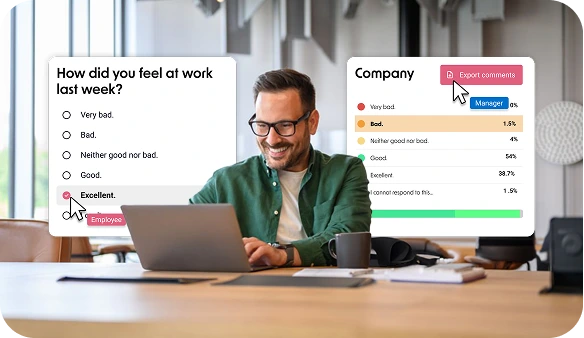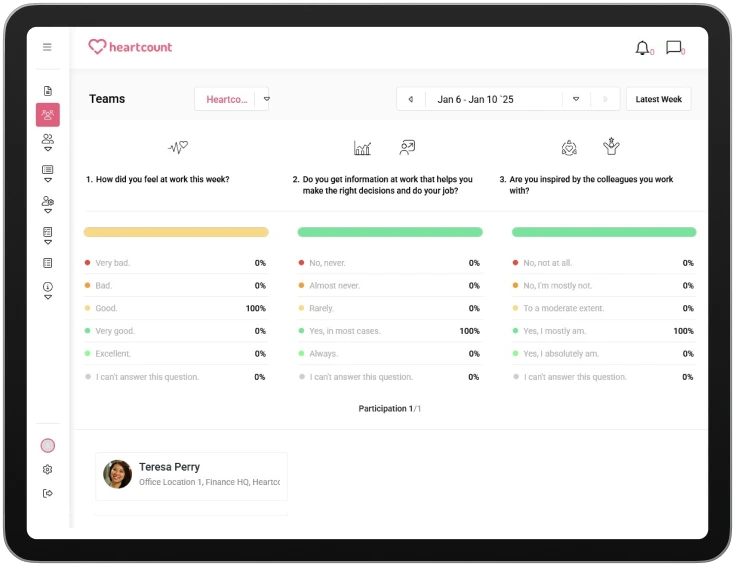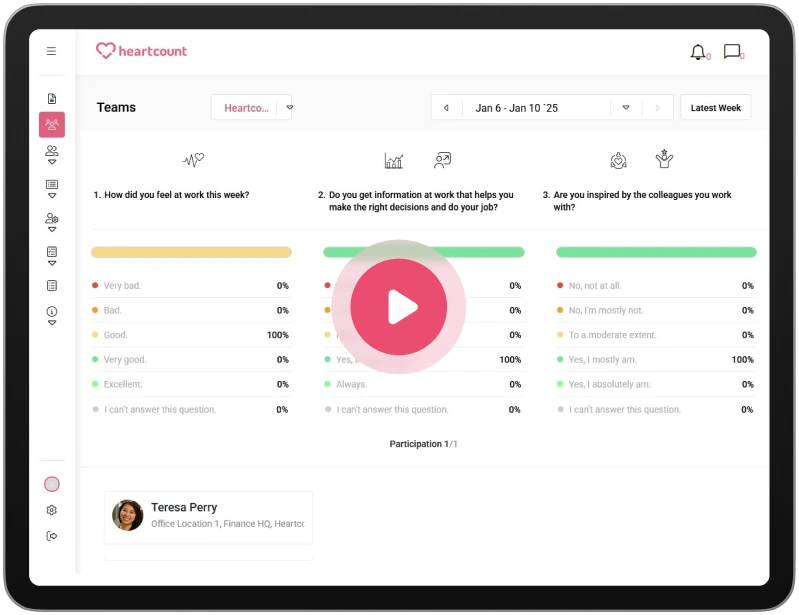What Is an Employee Feedback Loop and How Does It Work?

A motivated and engaged workforce is essential for any organization’s success.
Employees who feel valued and connected to their work are more engaged, productive, and more committed to staying with the company.
On the other hand, neglected employees can feel disconnected from management. This can make them disengaged, leading to lower productivity and higher turnover.
This disconnection can cause serious problems, affecting both team morale and the organization’s bottom line.
How can you ensure your employees feel respected, heard, and motivated?
Implement effective feedback loops.
-
1.What is an employee feedback loop?
-
2.The purpose of continuous employee feedback
-
3.What is a closed feedback loop?
-
4.Effective feedback mechanisms in the workplace
-
5.The best practices for implementing feedback loops in organizations
-
6.How to evaluate a feedback loop?
-
7.Positive feedback loop in the workplace examples
-
8.How to leverage technology for an effective feedback loop?
A motivated and engaged workforce is essential for any organization’s success.
Employees who feel valued and connected to their work are more engaged, productive, and more committed to staying with the company.
On the other hand, neglected employees can feel disconnected from management. This can make them disengaged, leading to lower productivity and higher turnover.
This disconnection can cause serious problems, affecting both team morale and the organization’s bottom line.
How can you ensure your employees feel respected, heard, and motivated?
Implement effective feedback loops.
What is an employee feedback loop?
A feedback cycle, also called a feedback loop, is a process of collecting, analyzing, and using information about an employee’s performance, project progress, or team dynamics.
The feedback loop is used to make continuous improvements. This includes regularly giving and getting feedback to and from employees, teams, and management. It’s used to improve efficiency, productivity, and job satisfaction.
Feedback is not a one-way street.
It works both ways.
Team leaders provide regular feedback to employees. The feedback helps them refine their goals and behaviors for continuous improvement.
On the other hand, employees share their suggestions with team leads during one-on-ones, team meetings, or through surveys. Team leads then use this feedback to make changes or respond accordingly.
This two-way cycle of giving and receiving feedback creates a culture of continuous improvement.
The types of feedback loops
There are two main types of feedback loops in the workplace: positive and negative.
- Positive feedback loops are all about reinforcing and amplifying good behaviors or processes.
When you recognize and reward an employee for their excellent work, it motivates them to continue performing at a high level. This type of feedback creates a cycle of ongoing motivation and improvement. It encourages employees to keep up the good work and strive for even better results. - Negative feedback loops are designed to address and correct issues and resolve challenges.
However, negative feedback is not about criticism but rather about guiding employees towards better performance.
The difference between positive and negative feedback loops
Understanding the difference between positive and negative feedback loops is crucial. It’s a key to managing performance and fostering a productive work environment.
Positive Feedback Loops
The purpose is to encourage desired workplace behaviors, achievements, and processes.
Positive feedback loops form when individuals receive continuous praise or rewards for their performance. This motivates employees to continue or even increase their efforts, creating a cycle of ongoing motivation and improvement.
For example, to create a positive feedback loop in your workplace, you can practice:
- Recognition Programs -Awarding an employee of the month for exceptional performance.
- Peer-to-Peer Recognition: Encouraging colleagues to recognize each other’s skills and efforts. Peer-to-peer recognition fosters a supportive and collaborative work environment.
With Heart Count’s Peer recognition feature, you can offer an interactive platform for your employees to give and receive praise from colleagues. All praises are visible to the entire organization and automatically logged in the employee’s record.

Benefits you can expect:
- Boosted workplace morale.
- Boosted confidence and self-efficacy.
- Increased motivation and employee engagement.
- Enhanced collaboration among teams.
- Reduction in employee turnover.
Negative Feedback Loops
Negative feedback loops aim to correct and improve behaviors and processes by addressing challenges and gaps. They form when individuals receive constructive criticism or feedback. The goal is to improve their performance.
This helps employees identify where to improve and make the appropriate adjustments. This establishes a cycle of ongoing improvement and stability.
For example, to establish a negative feedback loop at your company, you might implement:
- Performance Reviews: Addressing areas of improvement during formal evaluations.
- Constructive Criticism: Offering specific, actionable feedback on how employees can improve their work during one-on-one meetings or casual conversations.
Benefits you can expect:
- Improved employee performance.
- Increased accountability.
- Enhanced productivity.
- Stabilized work processes.
- Strengthened workplace relationships.
Stages of the feedback loop process
Creating an effective feedback loop is essential for maintaining a positive and productive work environment.
To ensure you’re incorporating the feedback loop in the right way, take into account the following steps:
- Feedback Collection. Gather employee feedback through various channels such as pulse check surveys, interviews, focus groups, suggestion boxes, or stay interviews.
- Analysis and Evaluation. Analyze the collected feedback to identify patterns, trends, and key insights. Pay attention to whether the information is overall positive, negative, or neutral.
- Communication and Reporting. Communicate the insights obtained from the feedback analysis to team leads or department heads. Be transparent and show both points of success and gaps for improvement.
- Action and Implementation. Take action based on the knowledge and understanding gained from the current situation. It is crucial to act upon the feedback. Showing employees that their input has influenced decision-making will lead to tangible outcomes.
The main components of feedback loops
Let’s break down the parts of a feedback loop. We will see how they combine to make a powerful tool for improvement.
Input
This is where it all begins. It’s about gathering honest opinions, ideas, concerns, and suggestions to understand the current state of the work environment and processes.
Good practice involves gathering input from a wide variety of stakeholders and using multiple methods, such as surveys, focus groups, or interviews, to get diverse perspectives.
Bad practice. Relying only on input from a small group of senior leaders.
Processing
Once the input is collected, it’s time to process the information. This involves organizing the feedback to identify key points and patterns.
Good practice. Analyzing the input data objectively and systematically. Using proven techniques like data visualization or coding qualitative data to calculate statistics and uncover trends.
Bad practice. Dismissing certain input answers without fully understanding them. Making assumptions without thoroughly examining the data.
Comparison
This component helps pinpoint potential gaps between current performance and desired outcomes.
Good practice. Comparing the input data to well-defined benchmarks, goals, or standards that were set beforehand in consultation with relevant parties.
Bad practice. Comparing input to vague or unrealistic targets that were not properly established upfront.
Feedback
This component helps communicate processed information back to employees and stakeholders. It’s about sharing insights, acknowledging contributions, highlighting areas that need attention, and fostering a culture of transparency and trust.
Good practice. Providing specific, constructive feedback to stakeholders on what the data says is working well and what could be improved.
Bad practice. Not sharing the results of the analysis. Only selectively sharing positive feedback without being transparent about weaknesses.
Action
Taking action is crucial. Based on the feedback, necessary changes or improvements are implemented. This could mean updating policies, refining processes, or launching new initiatives.
Good practice. Developing an action plan based on the feedback with clear accountabilities, timelines and resources. Test and implement recommended adjustments.
Bad practice. Not taking action or making changes even when the feedback points to a need for improvement.
Evaluation
After taking action, their effectiveness needs to be evaluated. This involves assessing whether the changes made have had the desired impact.
Good practice. Following up after implementing adjustments to collect new input data and evaluate. Find out if/how the changes addressed issues previously identified.
Bad practice. Failing to evaluate if the actions taken had the intended impact or result.
Adjustment
This step fixes any remaining issues. It also fine-tunes the solutions for better results.
Good practice. Willingness to revise plans, strategies, or processes based on what is learned from each feedback and evaluation cycle.
Bad practice: dismissing learnings that contradict existing ways of doing things; not adjusting approaches even when evidence suggests they are needed.
The feedback loop is a continuous process. Iteration means repeating the cycle. Gathering new input to refine and improve processes continually.
The purpose of continuous employee feedback

Studies have shown that companies prioritizing employee feedback cultivate a stronger and more positive company culture.
Employees today prefer continuous feedback over annual reviews. They want timely insights and recognition to guide their performance and career growth.
Organizations must adapt to this need by implementing systems that provide regular feedback.
With open communication and guidance, employees can maximize their potential and ensure their efforts align with company objectives.
Instant recognition of achievements, no matter how small, keeps employees motivated.
Frequent check-ins allow managers the opportunity to notice and praise a job well done in real time.
Continuous feedback helps companies stay informed about employee performance and well-being. Both parties gain valuable insights to strengthen working relationships and productivity.
This culture ensures the feedback loop is effective and sustainable over the long term.
Here’s why continuous feedback is essential for both sides, employees and team leads:
The Importance of Continuous Employee Feedback for Both Employees and Team Leads | For Employees | For Team Leads |
| Drives Employee Growth | Helps set and achieve goals with actionable suggestions for improvement. | Understand team strengths and provide targeted support and development. |
| Provides Real-Time Insights | Addresses issues and removes barriers before they escalate. | Stay informed about team performance and morale for better decision-making. |
| Improves Employee Engagement | Fosters a sense of being valued, boosting engagement and productivity. | Benefits from higher productivity and a positive work environment. |
| Facilitates Faster Problem Resolution | Prevents problems from festering and keeps the team motivated. | Maintains team morale and productivity by resolving issues promptly. |
| Reduces Employee Turnover | Builds loyalty and trust, reducing the likelihood of leaving the organization. | Saves time and resources on recruiting and training, allowing focus on long-term goals. |
| Provides Specific, Unbiased Feedback | Reduces bias and vagueness, giving clear guidance on improvement. | Ensures fair and actionable feedback leads to better team performance and morale. |
COLLECT
What is a closed feedback loop?
A closed feedback loop is a systematic process of collecting, analyzing, and acting on feedback to continuously improve a system or process. It’s not just about collecting data but about using that information to make meaningful changes.
A closed feedback loop ensures that the process of improvement never stops.
By closing the loop, leaders can identify what works and what doesn’t. This process allows for rapid adjustments and fine-tuning. It ensures that strategies remain relevant and effective.
Effective feedback mechanisms in the workplace
Creating a workplace where feedback is both effective and continuous is essential. It fosters growth, improves performance, and keeps employees engaged.
According to the Harris Poll’s “The State of Business Communication in 2023,” effective communication significantly boosts productivity and job satisfaction.
The report highlights that 72% of business leaders believe effective communication has increased their team’s productivity, while 52% of knowledge workers agree.
Additionally, 60% of business leaders and 56% of knowledge workers noted that effective communication has increased employee confidence.
Scheduling frequent, structured meetings between team leads and employees is an effective mechanism. Use them to discuss performance, goals, and any issues that arise. Regular check-ins keep communication ongoing and proactive.
Alongside the regular check-ins, anonymous surveys can be a valuable tool.
Employees may feel more comfortable sharing their true thoughts when anonymity is guaranteed. It reveals critical insights hidden from face-to-face conversations.
Try not to focus only on areas of improvement. Positive reinforcement is another key element of effective feedback.
Lack of recognition is one of the main reasons people leave their jobs (Source). This underscores the critical need for regular acknowledgment in the workplace.
Regular praise and recognition can significantly boost productivity, with employees who receive such recognition being 10-20% more productive. (Source)
Over half of the employees surveyed (52.5%) expressed a desire for more recognition from their immediate manager, while 41% wanted more recognition from their coworkers. This emphasizes the role of peer acknowledgment in fostering a supportive work environment.
Timeliness is key to effective feedback.
Real-time feedback ensures that employees can immediately understand what they did well or where they need to improve. This makes the feedback more relevant and actionable.
The best practices for implementing feedback loops in organizations
Talent development needs vary by company. But, successful feedback loops all share these basic parts:
Establish clear objectives.
Start by defining what you aim to achieve with your feedback loops. Clear objectives will guide the process. They’ll improve employee performance, increase engagement, and enhance productivity. They’ll ensure that everyone is on the same page.
Create open communication channels.
Encourage employees to share their thoughts, ideas, and concerns through various channels.
Employees who feel heard are 4.6 times more likely to feel empowered to perform their best work. (Source)
Provide training for managers.
Constructive feedback, whether negative or positive, when delivered appropriately, enhances performance according to 92% of respondents of employee survey.
Equip team leads and heads of departments with the skills they need to give effective feedback.
Implement feedback technology
Use employee experience software such as HeartCount.
It will help you establish a measurable feedback loop of employee engagement, sentiment, and well-being. HeartCount can automate feedback collection, analysis, and reporting, making the process more efficient.
Analyze and act on feedback
Collecting feedback is only the first step. Use these insights to make informed decisions and implement necessary changes. Acting on feedback shows employees that their opinions are valued. This can lead to employee engagement and retention.
Follow up and adjust.
Revisit and adjust your strategies. Ensure that the feedback loop remains dynamic and responsive to evolving needs.
Foster a feedback culture
Cultivate an environment where feedback is viewed as a positive and integral part of the workplace.
Organizations with an engaged workforce are 21% more profitable.
Encourage openness and trust. Make sure that employees feel safe and valued when providing their input.
UNDERSTAND
How to evaluate a feedback loop?

To develop a successful feedback loop, understanding your employee’s needs and demands is crucial.
You can start by defining what you want to achieve with your feedback loop. Knowing your objectives sets the stage for a successful feedback loop.
Gather feedback. Begin with straightforward surveys that ask essential questions. As employees become accustomed to participating, introduce more complex questions for detailed answers.
When analyzing data, look for patterns and trends in the feedback. You can create an employee experience journey map. It’ll help you visualize and understand the employee’s touchpoints. It’ll help you pinpoint where changes are needed.
Quantity is important.
Track how many employees are giving and receiving feedback. High participation indicates a healthy feedback culture.
Assess the changes made based on feedback. Test the impact on key business priorities.
Not sure if your feedback loop is effective?
Ensure your feedback loop is agile and responsive. If it takes weeks or months to collect, analyze, and act on employee input, it loses its effectiveness.
Be flexible. If something isn’t working, be ready to tweak the feedback process.
Positive feedback loop in the workplace examples
Manager to Employee Positive Feedback Examples
- Recognize achievements. Highlight employee’s accomplishments.
- Appreciate effort. Acknowledge the hard work an employee puts in, regardless of the outcome.
- Encourage growth. Support employee’s professional development through training and career advancement opportunities.
- Validate an initiative. Appreciate employees who take the initiative. It shows that proactive behavior is noticed and rewarded.
- Recognize collaboration. Highlight teamwork and collaborative efforts. It reinforces the importance of working together to achieve common goals.
- Show gratitude for their support. Thank employees for their support and assistance. It shows that their contributions to the team’s success are appreciated.
- Give positive reinforcement. Provide positive feedback for desired behaviors. It encourages employees to continue exhibiting those behaviors.
- Celebrate milestones. Acknowledge work anniversaries, project completions, or other significant milestones. It demonstrates that the company values long-term contributions and accomplishments.
Peer to Managers Positive Feedback
- Express pride in a growth mindset. Praise a manager for fostering a culture of continuous learning and development.
- Honor dedication to leadership. Recognize a manager’s commitment to guiding and supporting their team effectively.
- Express gratitude for empathetic leadership. Thank managers for their understanding and compassionate approach to leadership.
- Appreciate a manager’s proactive communication. Highlight a manager’s efforts in maintaining open and proactive communication channels.
- Honor managerial adaptability and change. Praise a manager’s ability to adapt to changes and lead the team through transitions.
Positive feedback to colleagues
- Acknowledge team contributions. Recognizing a colleague’s contribution to team efforts highlights the importance of collaboration.
- Encourage continuous improvement. Supporting a colleague’s efforts to improve encourages ongoing development.
- Show gratitude for their support. Thank a colleague for their support, and help to show appreciation for their teamwork.
- Recognize a positive attitude. Highlight a colleague’s positive attitude, as it promotes a positive work environment.
- Show gratitude for collaboration. Thank a colleague for their collaborative efforts. It’s a reinforcement of the importance of working together towards common goals.
ACT
How to leverage technology for an effective feedback loop?
You need a reliable tool to measure and analyze employee feedback in real-time. Without it, collecting the needed information is hard.
HeartCount can greatly improve the way you collect, analyze, and implement feedback.
Automating and standardizing feedback collection with HeartCount ensures systematic and consistent data gathering. It facilitates timely feedback, which is crucial for its immediate relevance and effectiveness.
Advanced data analytics transform raw feedback into actionable insights. It helps identify trends, predict outcomes, and deepen understanding.











